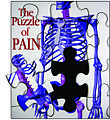 If you have chronic pain when walking it means that you need to change the way you walk. And while I am all about walking correctly, in the context of chronic pain I’ll settle for walking better. We are designed to move in a fairly organized way with well aligned bones and balanced muscles. Failing to find decent movement patterns affects all parts of the body. A turned out foot can create dysfunction in the shoulder. Tight hips can can mess with the knees and/or lower back if they can’t rotate in and out of their sockets correctly (this is because if the hips don’t rotate the knee and/or lower back have to pick up the rotational slack).
If you have chronic pain when walking it means that you need to change the way you walk. And while I am all about walking correctly, in the context of chronic pain I’ll settle for walking better. We are designed to move in a fairly organized way with well aligned bones and balanced muscles. Failing to find decent movement patterns affects all parts of the body. A turned out foot can create dysfunction in the shoulder. Tight hips can can mess with the knees and/or lower back if they can’t rotate in and out of their sockets correctly (this is because if the hips don’t rotate the knee and/or lower back have to pick up the rotational slack).
Sit somewhere in public and watch the way people walk. It isn’t pretty. And the way you walk can help, hurt, or even create a chronic injury.
Not everyone with chronic pain can find relief. There are many different conditions and circumstances that leave people in situations for which there might not be a cure (congenital diseases, structural defects) but it is my belief, and has been my experience, that a large percentage of people who suffer from chronic pain when walking, sitting or standing can at least alleviate a good portion of it by changing movement patterns. Everyone can benefit from the support of good posture and moving from the center.
Compensating for an injury by adjusting the way we walk helps the healing process, but, for whatever reason (the duration of the compensation is a major factor); we often keep or maintain the patterns we formed even after the injury has healed. Changing the way you use your foot to compensate for the pain of the injury makes perfect sense. But once you heal the idea is to return to the pattern you employed before the injury. That isn’t happening as often as it should.
In fact I come across the exact opposite much of the time. Due to a lack of awareness of technique so many people are creating chronic pain and injury because of the way that they walk. The initiation of movement should come from the core of the body, the space between the bottom of the pelvis and the base of the rib cage. That is what we are talking about when we say CoreWalking.
Instead, most people are walking through the outer shell rather than the inner core. It is easy to know which group you are in. Simply check the bottom of some well worn shoes. Everyone’s outer heel should wear out–that is perfectly normal– but towards the front of the foot the shoe should wear out evenly across the ball of the foot. Many too many people are wearing out their shoes along the outer edge and not getting nearly enough of the ball of the foot involved.
When we move through the core we finish each step, as designed, on the inner foot at the big toe. Getting that powerful push off from the big toe activates the core in a positive example of of how good movement patterns affect all parts of the body.
Chronic pain when walking is an all too common occurrence for no good reason. It is easy to change the way you walk to begin to find relief. You just need to learn how.
